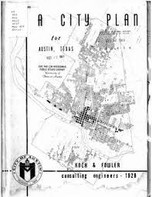How Austin Became Segregated: The City Plan of 1928
Introduction
Text-to-speech Audio
The City Council of Austin decided that they needed a comprehensive city plan and zoning map in 1927. One of the leading objectives of the all-white Council was to find a way to encourage residential segregation and find a way to compel Black families, who at that time were living throughout the city, to move to East Austin. The city used techniques such as eliminating utility services in certain areas where Black citizens lived in order to force them from their homes and neighborhoods. Private developers then purchased these areas at very low prices and built new roads, homes, and commercial buildings. When these same neighborhoods "re-opened," higher rents and restrictive covenants prevented African American families from returning. Because of these same practices, the displaced minorities had few choices but to find housing in areas the city reserved for non-whites.
The Great Depression accelerated the process, and by the mid-1930s nearly every Black family lived in East Austin which the city unapologetically labeled "The Negro District." This allowed the city to close Black schools in other parts of the city. For example, in 1931 the city closed the all-Black Wheatsville School after 60 years because so few Black families lived downtown. After Wheatsville was closed, Black children who still lived downtown were transferred to the E. H. Anderson School in East Austin. This measure placed added pressure on Black families to move to East Austin so that their children could attend a neighborhood school. Black institutions beyond East Austin also faced extreme prejudice from city officials that threatened their continued existence if they did not "voluntarily" relocate. For example, a Black business or church might be denied permits or service from public utilities.
Ten years later, the city created Santa Rita Courts, the nation’s first federally funded housing project. The city claimed that their intention was to provide a low-cost housing option for Latinos. At the same time, documents reveal that the city hoped that their twin practice of eviction and construction of housing projects would compel non-white families living downtown to move to East Austin. Between racially restrictive covenants prevented non-whites from occupying certain neighborhoods, and because of the general lack of affordable housing in the city, East Austin became home to the majority of the city's African American and Mexican American residents.
This pattern of residential segregation persisted with little change until the late 1990s. Urban growth and gentrification, along with urban development planning, have led parts of East Austin to become a desirable location among affluent young whites and students at the University of Texas at Austin. In fact, a section of East Austin is today known as "The Hippest Hipster Neighborhood" in America.
Images
The City Plan of 1928 explicitly stated that one of its leading goals was to compel African Americans to leave their homes and remove themselves to a "Negro District."

Backstory and Context
Text-to-speech Audio
The city defended its actions as a measure to reduce racial friction. Many whites likely believed (or at least convinced themselves) that residential segregation would benefit African Americans. Despite numerous statements in 1927 and 1928 claiming that they were acting in the best interest of all citizens, the prime motivation was to find a way to legally remove nonwhites from the city center as evidenced by the following sections of the City Plan of 1928. The documents make it clear that the city understood that their intentions violated the US Supreme Court's decision in Buchanan v. Warley (1917) that barred cities from deliberately creating segregated neighborhoods.
"There has been considerable talk in Austin, as well as other cities, in regard to the race segregation problem. This problem cannot be solved legally under any zoning law known to us at present. Practically all attempts of such have been proven unconstitutional.
"There has been considerable talk in Austin, as well as other cities, in regard to the race segregation problem. This problem cannot be solved legally under any zoning law known to us at present. Practically all attempts of such have been proven unconstitutional.
In our studies in Austin we have found that the Negroes are present in small numbers, in practically all sections of the city, excepting the area just east of East Avenue and south of the City Cemetery. This area seems to be all Negro population. It is our recommendation that the nearest approach to the solution of the race segregation problem will be the recommendation of this district as a Negro district.
This will eliminate the necessity of duplication of white and Black schools, white and Black parks, and other duplicate facilities."
Cite This Entry
Trowbridge, David J.. "How Austin Became Segregated: The City Plan of 1928." Clio: Your Guide to History. June 21, 2014. Accessed February 3, 2025. https://theclio.com/entry/5517
Sources
Jeremiah Spence, Joseph Straubhaar, Alexander Cho, and Dean Graber, Inequity in the Technopolis: Race, Class, Gender, and the Digital Divide in Austin. Austin: University of Texas Press, 2013.
Click the link below for more information or to purchase this book.





